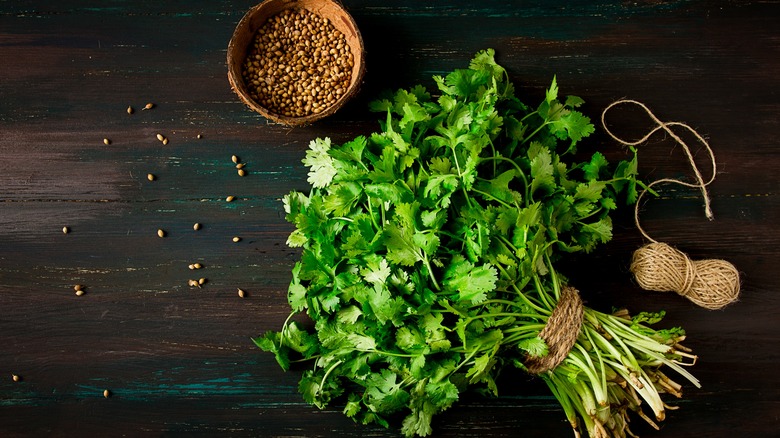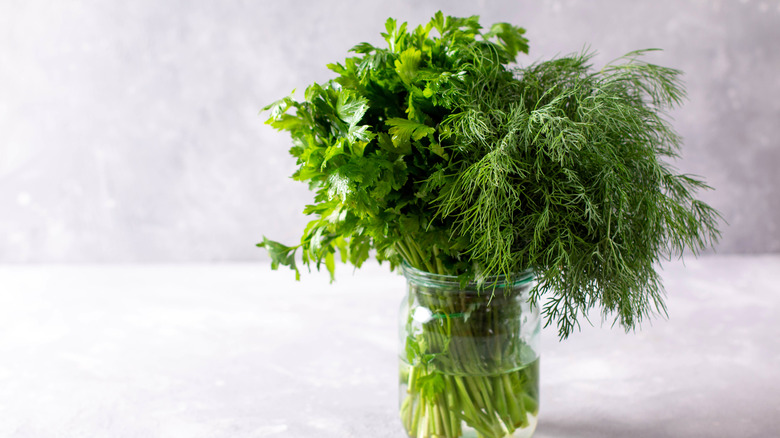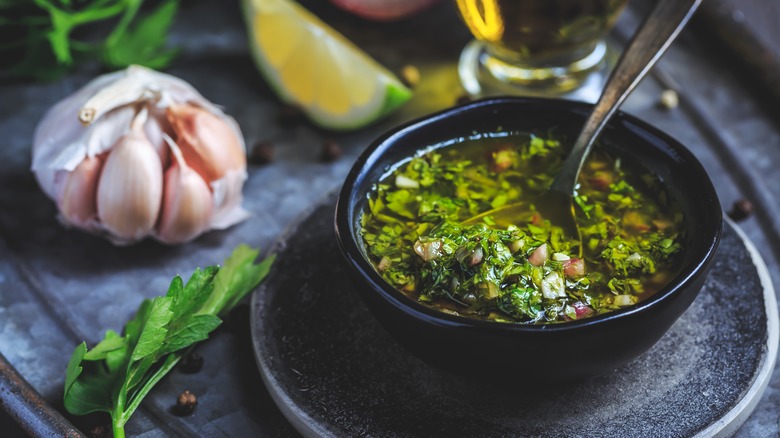The Extra Step You Should Take When Storing Cilantro In The Fridge
There's nothing worse than getting halfway through a guacamole recipe, only to find that your cilantro has turned rotten. Delicate leafy herbs can really suffer in the fridge, but you don't have to resign yourself to throwing out most of the bunch – there's an easy trick to keep your cilantro fresh for longer. Just store it like a bouquet of flowers.
Start by washing the cilantro and removing any leaves that are starting to brown or wilt. You might have heard that rinsing produce before storage makes it rot faster, due to excess moisture, but pre-washing actually isn't a mistake when storing herbs. Rinsing can extend their shelf life by removing residue and contaminants that speed up spoilage — just make sure to dry your herbs thoroughly afterward.
Next, trim the bottoms of your cilantro stems and place them leaf side-up in a jar of water, just like cut flowers. Cutting the stems helps them suck up the water. Finally, place a plastic baggie over top of the jar and zip until the bag forms a light seal around the container, then place the whole thing in the fridge. Cilantro needs to draw in moisture to stay perky, and the dry air of the fridge makes the leaves wilt, which is where the protective bag comes in. With this trick, you may be able keep cilantro for weeks as opposed to 2 to 3 days. If the water turns cloudy, just dump it out and replace it as needed.
How to buy fresh cilantro (and tell if it's gone bad)
While the "bouquet" storage trick can certainly help your cilantro out, it won't work nearly as well if your herbs are wilting to begin with. Next time you're shopping to make a falafel recipe or coconut rice with salmon and cilantro sauce, keep an eye an eye out for indicators of a great bunch of cilantro.
Firstly, cilantro should always be a bright, vibrant green. If you see a bundle with discolored leaves in shades of brown or yellow, leave it on the shelf. You can also look at the stalks, which should be pale green and plump, not discolored or bendy. The herb's scent will tell you about its freshness, as well. Look for cilantro that smells citrusy and a little earthy, avoiding bunches with an "off" smell or no smell at all. Finally, take advantage of cilantro in its peak season, which runs from May to September. You'll be able to find the freshest and most flavorful stalks right then.
Of course, even with best storage practices, cilantro will eventually rot. You can tell it's close to going bad if the leaves start to turn yellow. After this, they will begin to wilt and turn brown and slimy. The herb will also give off a dank and unpleasant smell that is hard to miss. At that point, it's time to throw it out or compost it.
More ways to extend cilantro's shelf life
If you're faced with cilantro that's starting to wilt (but hasn't yet turned into a slimy mess), you can still get some use out of it. While limp leaves won't make for a great garnish, you can still mix them into sauces, dressings, drinks, and chutneys. Try making linguine with cilantro and chive pesto, or blend the herb into a green juice or smoothie.
If you fear you can't use up a big haul of cilantro, it can be blanched to extend its lifespan. By dipping it in boiling water for just a few seconds, you kill certain enzymes in the plant that cause it to decompose. Drop the stems in ice water right after blanching to halt the cooking process and preserve that bright green color. Be sure to thoroughly dry it before storing it in the fridge again.
Blanching is also recommended if you want to freeze cilantro. Yes, you can simply freeze the leaves in a single layer in an airtight container, but blanching them first preserves their color and freshness much better. Either way, defrosted cilantro will be a bit too soggy for "raw" applications like fresh tomato salsa. Use them in blended or cooked recipes instead. Another option is chop cilantro finely and mix it with oil, then freeze it in an ice cube tray. You can then pull out a cube and toss it into soups, stir-fries, or sauces for a delicious pop of flavor.



